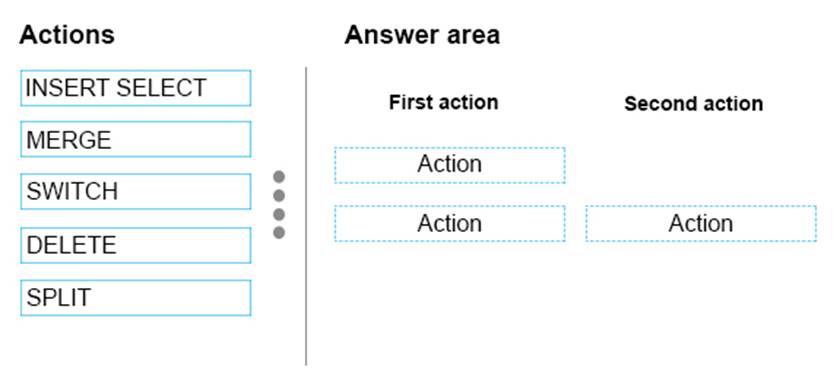DRAG DROP
Note: This question is part of a series of questions that use the same scenario. For your convenience, the scenario is repeated in each question. Each question presents a different goal and answer choices, but the text of the scenario is exactly the same in each question in this series.
You have a Microsoft SQL Server data warehouse instance that supports several client applications.
The data warehouse includes the following tables: Dimension.SalesTerritory, Dimension.Customer, Dimension.Date, Fact.Ticket, and Fact.Order. The Dimension.SalesTerritory and Dimension.Customer tables are frequently updated. The Fact.Order table is optimized for weekly reporting, but the company wants to change it daily. The Fact.Order table is loaded by using an ETL process. Indexes have been added to the table over time, but the presence of these indexes slows data loading.
All data in the data warehouse is stored on a shared SAN. All tables are in a database named DB1. You have a second database named DB2 that contains copies of production data for a development environment. The data warehouse has grown and the cost of storage has increased. Data older than one year is accessed infrequently and is considered historical.
You have the following requirements:
Implement table partitioning to improve the manageability of the data warehouse and to avoid the need to repopulate all transactional data each night. Use a partitioning strategy that is as granular as possible.
Partition the Fact.Order table and retain a total of seven years of data.
Partition the Fact.Ticket table and retain seven years of data. At the end of each month, the partition structure must apply a sliding window strategy to ensure that a new partition is available for the upcoming month, and that the oldest month of data is archived and removed.
Optimize data loading for the Dimension.SalesTerritory, Dimension.Customer, and Dimension.Date tables.
Incrementally load all tables in the database and ensure that all incremental changes are processed.
Maximize the performance during the data loading process for the Fact.Order partition.
Ensure that historical data remains online and available for querying.
Reduce ongoing storage costs while maintaining query performance for current data.
You are not permitted to make changes to the client applications.
You need to implement partitioning for the Fact.Ticket table.
Which three actions should you perform in sequence? To answer, drag the appropriate actions to the correct locations. Each action may be used once, more than once or not at all. You may need to drag the split bar between panes or scroll to view content.
NOTE: More than one combination of answer choices is correct. You will receive credit for any of the correct combinations you select.

Answer: 
Explanation:
From scenario: – Partition the Fact.Ticket table and retain seven years of data. At the end of each month, the partition structure must apply a sliding window strategy to ensure that a new partition is available for the upcoming month, and that the oldest month of data is archived and removed.
The detailed steps for the recurring partition maintenance tasks are:
References: https://docs.microsoft.com/en-us/sql/relational-databases/tables/manage-retention-of-historical-data-in-system-versioned-temporal-tables
Latest 70-767 Dumps Valid Version with 136 Q&As
Latest And Valid Q&A | Instant Download | Once Fail, Full Refund
